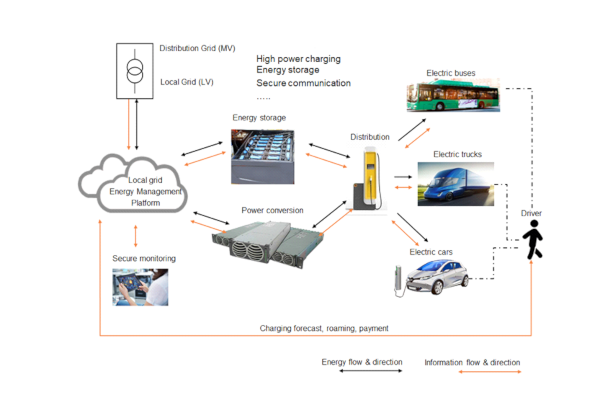Use case 2 – EV high-power charging infrastructure
Use-case 2 refers to the integration of various sub-systems developed by the PROGRESSUS partners, into a real life use-case operational in the field. These sub-systems are i) a protective interface between local grid and connected power processing converters such that the system is able to withstand either under voltages or too high peak voltages as originated from the middle voltage grid side, while not being over-dimensioned, ii) a cloud based smart charging framework, where different inputs (like energy prices, weather forecasts grid measurements, user inputs, etc.) can be used and where different algorithms can easily be applied and configured.
Part of this development is an advanced smart charging simulation tool, running in parallel to the actual smart charging algorithm, which can be predict the effects of smart charging prior to the start of the session. This is done using machine learning to predict coming events like the arrival of vehicles at a location, the energy need of those vehicles, their parking time, the local energy production, local grid constraints, energy tariffs, etc. With this forecast, EV-drivers can select their charging stations based on its expected average output power fitting their traveling requirements. This information is shared via mobile Apps and (to be updated) roaming interfaces, iii) the high-power charger with integrated battery providing 450kW output and <150kW input, iv) the multiple high power fast DC chargers connected to a single transformer and v) a proof-of-concept of a 200 kW EV charger based on wireless power transfer for opportunity charging of e-buses.
PROGRESSUS targets to optimize the efficiency of the subsystems when they will be integrated into the main system, while the real life testing of the system will give valuable input to the evaluation and further fine tuning of the system. Moreover, harmonics and resonance of the integrated system will be studied. The impact of different parameters, including the impedance and load of the grid, the hardware in particular the power filter, control, and operation point of the charger, etc., on the harmonics and resonance will be taken into account. Grid friendly control strategies and power filter design of the charger will be proposed to mitigate the harmonics and damp the resonance in the grid.



